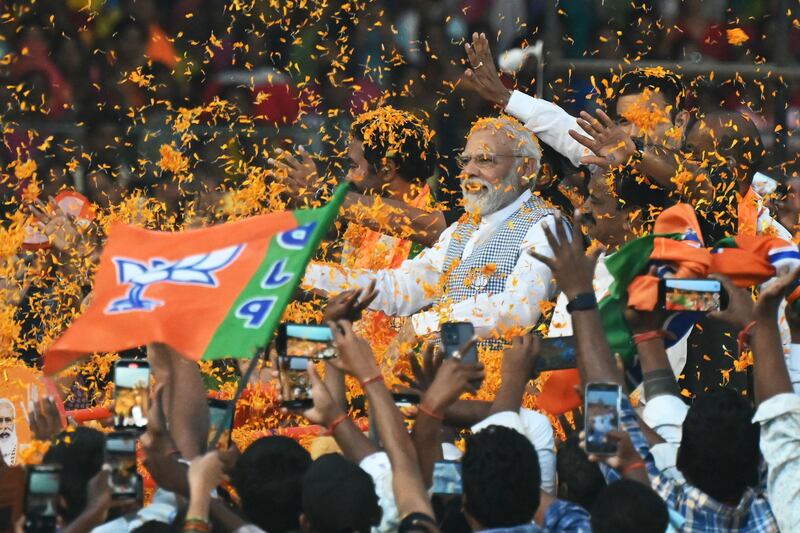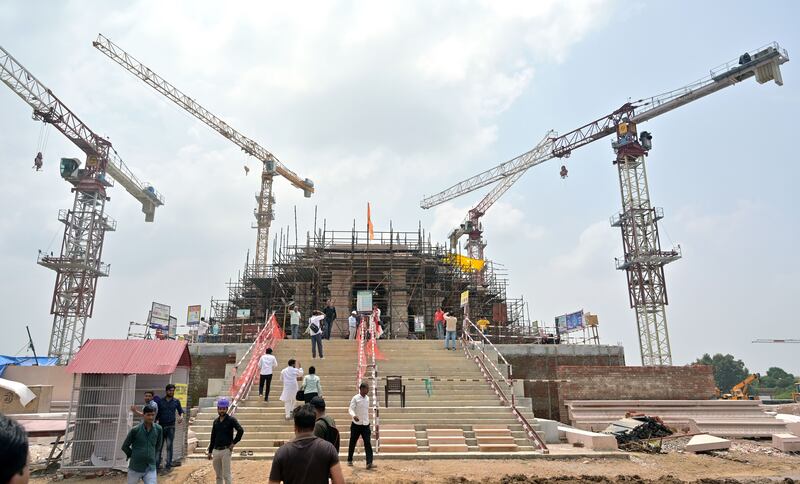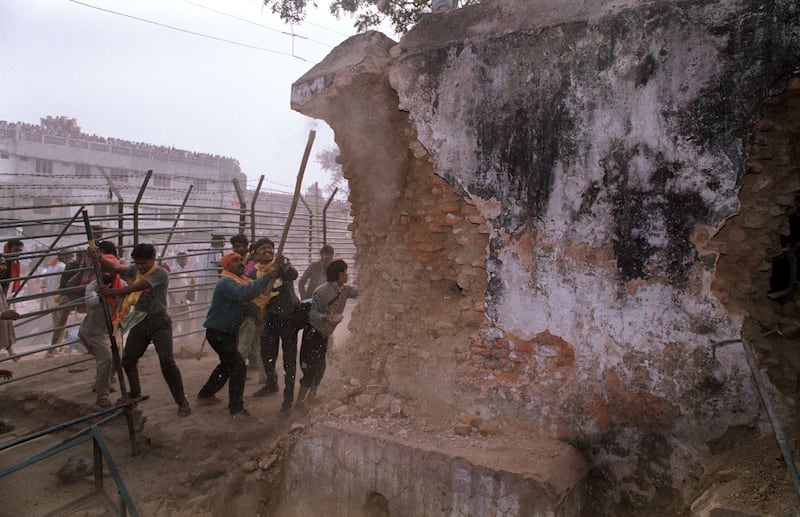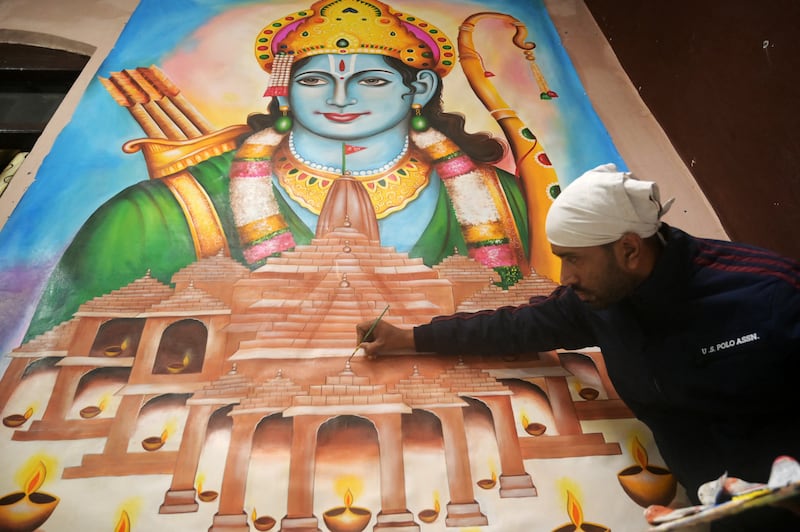On Monday, prime minister Narendra Modi will inaugurate a grand Hindu temple in northern India, built on the site of a 16th-century mosque whose demolition by Hindu zealots 32 years ago triggered countrywide sectarian riots in which more than 2,000 people, mostly Muslims, died.
The temple at Ayodhya, 680km southeast of New Delhi, is dedicated to the Hindu god Ram and has dominated the politics of Modi’s Hindu nationalist Bhartiya Janata Party (BJP) since the 1980s. And like the extended turmoil and chaos leading up to its construction, which began in 2020, the run-up to Monday’s unveiling remains every bit as contentious, controversial and communally divisive.
“The Ram temple is squarely a political project,” wrote columnist Ramesh Venkataraman in the Indian Express on Thursday. “Like the temples of yore, it is a monument to the Modi regime’s power and burnishes its Hindu credentials,” he added.
[ Modi founds Hindu temple on site of razed mosque in Indian townOpens in new window ]
The bitter acrimony over the temple’s inauguration centres on the standoff between the BJP and opposition parties, which accuse Modi of “politicising” the unveiling of the incomplete temple complex ahead of the general elections, which are expected to take place in April or May. They charge him with targeting Hindu voters through the temple opening, with the aim of winning a record third consecutive term in office.
READ MORE
An large number of Hindus, comprising about 80 per cent of India’s population of more than 1.4 billion, revere Ram. India’s social and mass media indicated that many backed the BJPs crusade to build the temple in Ram’s name centuries after its original structure was, Hindus claim, destroyed to build a mosque.
Tens of thousands of neighbourhoods across the country are organising celebratory functions, while the federal government has declared a half-day holiday on Monday to mark the temple’s investiture.

However, opposition Congress Party leader Rahul Gandhi condemned Modi and the Hindu revivalist Rashtriya Swayamsevak Sangh (RSS) – which has close ideological and organisational links with the BJP – for turning the temple’s consecration into an “election function”. He told reporters it would be difficult for the Congress Party to attend a function that is designed around the prime minister and the RSS.
Other opposition leaders, also contemplating avoiding the temple ceremony, face a seemingly irresolvable dilemma; if they boycott it, many fear they could be branded anti-Hindu by voters and lose their support. But by attending it, they believe would be playing into the BJP’s hands, and electorally giving Modi the advantage by publicly endorsing the temple project.
Even the quartet of Hinduism’s high priests, the Shankaracharyas, who are responsible for interpreting ancient scriptures, declined to join the occasion on grounds that Modi’s presence imparted a “political angle” to the proceedings. They also objected to the prime minister inaugurating an unfinished temple complex that was scheduled for completion only by early 2025.
Costing the equivalent of €2 billion – raised allegedly through public donations – the multi-pillared, three-storey-high pink sandstone temple is spread over 2.7 acres and built over the spot Hindus believe to be Ram’s exact birth place.
Its elaborate architecture is rooted in Hindu tradition. Specially minted bricks, each bearing the inscription “Jai Shree Ram” or “Glory to Ram”, have been used in its construction. The temple’s principal deity is a 1.3m-high idol of an infant Ram, which officials estimate will be visited daily by more than 150,000 devotees.

The once nondescript pilgrim town of Ayodhya, which has more than 1,000 Hindu temples, has undergone a €3.5 billion makeover in keeping with the BJP’s vision of fashioning the township as “Hinduism’s Vatican” and creating a “world-class city”.
Its narrow and crowded serpentine alleyways have been replaced by wide roads and walkways after scores of houses, shops and other buildings were arbitrarily demolished by bulldozers. The medieval town now boasts an international airport and a state-of-the art rail station. Numerous luxury hotels and malls are nearing completion.
Most building facades across the revamped township have been uniformly painted in Hinduism’s colours of cream and saffron, and adorned with Hindu-themed artwork such as swastikas, bows and arrows, conches, maces and inscriptions of “Shree” or “Lord Ram” in the local Hindi script.
The Ram temple’s antecedents have historically been mired in dispute and violence. Hindus maintained the original structure was demolished by India’s first Mughal ruler in the 16th century to build the Babri mosque in its place.
Over decades, the convoluted counter claims by both communities, suffused with legal, mythological, ecumenical and archaeological complexities, rumbled on until the 1980s when the BJP and its allied Hindu organisations began a concerted movement to “reclaim” the site and erect a Ram temple.

Frequent Hindu-Muslim clashes ensued and in late 1992 cadres from the BJP and its affiliates, armed with crowbars and hammers, levelled the mosque. Although an inquiry into the incident – lasting more than 17 years – held 68 people, including senior BJP leaders, culpable, no indictments followed.
The provocative matter was finally resolved by India’s supreme court in 2019 when it handed over the disputed site to Hindus to build a temple in exchange for a plot of land granted nearby to Muslims for a mosque.
In the ensuing years the BJP successfully exploited the Ram temple issue for electoral gain by raising the historical bogey of Hindu domination by Muslims, who comprise about 15 per cent of India’s population.
This, in turn, led to the BJP’s ascent to federal power, first in 1998 and once again a year later, in coalition governments. In 2014 and in 2019 the BJP, led by Modi, who championed Hindu nationalism, emerged as the only party in nearly three decades to single-handedly win a parliamentary majority.
Meanwhile, Modi is readying himself for the temple’s inaugural ceremony by fasting for 11 days, feeding cows – sacred to Hindus – and criss-crossing the country to offer prayers at numerous temples associated with Ram. He has also been sweeping some temples clean with a broom as a form of Hindu penance, which has earned him public accolades.

- Sign up for push alerts and have the best news, analysis and comment delivered directly to your phone
- Find The Irish Times on WhatsApp and stay up to date
- Our In The News podcast is now published daily – Find the latest episode here













